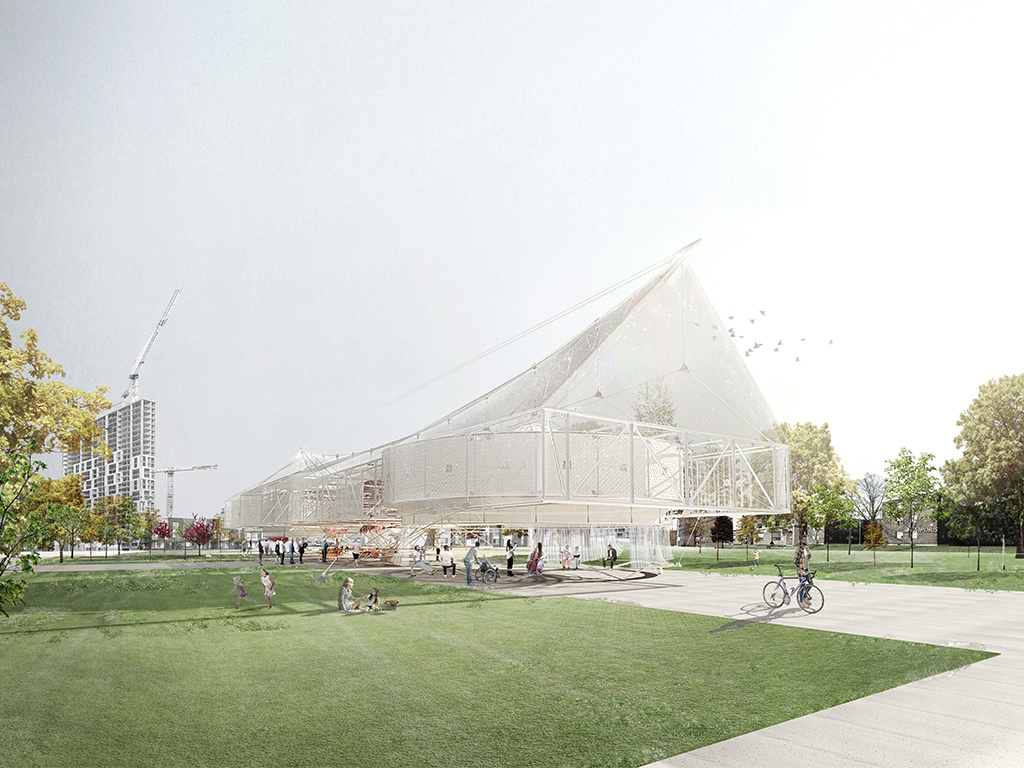Undergraduate Student Thomas Gomez Ospina Wins ACSA Steel Competition
Fourth year undergraduate student Thomas Gomez Ospina’s sophisticated design proposal for a modular canopy, Clouds Over Regent Park (external link) , won the ACSA 2021 Steel Design Student Competition (external link) in one of two categories (external link) . With over 1,200 participating students, the competition category allows for the selection of a site, any building type, and any building program with steel as the primary material.
Why did you choose Regent park in Toronto as your site?
I really value creating community impact through design. Regent park is a great example of how diverse communities in Toronto have come together to learn from a complicated past. So, I see the project as an opportunity to explore how to heal historic wounds. There's a lot of historic controversy in Regent Park tied to violence, crime, and poor urban planning. I see the role of an architect as bringing the community together for a better future. I actually worked in construction on one of the housing projects there a long time ago, during a civil engineering internship before transferring to architecture at DAS. It was there that I became much more interested in the community itself. And, Regent Park has a large immigrant population--as an immigrant myself, I'm really interested in learning about different cultures and celebrating our differences. I think Clouds Over Regent Park celebrates diversity in how it accommodates all of these different activities that take place in the community, and I think it also communicates a sense of pride in the community as a whole. That’s what’s great about being in Toronto, and at DAS - we have such a diverse student population who all have very different approaches to design problems, and that is such a great environment to be in when considering different perspectives in the creative process.


Can you speak to your design process a bit more?
I began with the idea of the role that individuals can play in giving form to architecture. I didn't want the design to be static, but rather responsive to human activity. Using structural steel would allow for this kind of dynamism while also remaining light and flexible. This led to the analogy of the "cloud" as a formless, light mass above our heads that changes shape in response to external forces. The idea is also that the community gets to define that form in the process, through their engagement with the structure and the space. Clouds also remind us that we all live under the same sky: it’s suggestive of a space in which everyone understands that they are part of a greater whole.
Regent Park is so unique and multifaceted - you have artists, entrepreneurs, restaurants, dance studios, and athletic grounds for example. I wanted to provide a space that could capture all of these diverse activities. Steel has the technical capacity to assemble different modular frameworks together. There’s also this ability to achieve a ‘lightness’ by maximizing the tensile properties of steel--and so when I conceived the structure as airy and ephemeral, I realized that I could suspend the structure above the landscape and have it float in a kind of ambiguous way on the site, but in a welcoming way as well: it’s very open to interpretation. Steel allows for the canopy to ‘hover’ above the ground, which opens up the space underneath for people to use in any number of ways that suits them.
Because of the way it’s designed, you can deploy any number of structures and the canopy also acts as a storage space: a scissor system can deploy modules for the farmers markets, a suspended performance rig can be pulled down for shows, or partitions can slide around for exhibitions, and then they can all be stored back into the ‘cloud’. It’s really several little canopies inside this much bigger ‘cloud’ - which goes back to how all these separate activities are taking place as part of the Regent Park community as a whole.

How has being a student at DAS helped you approach this challenge?
It was really important to understand how to put together a well thought-out structure. As much as a bigger concept is important, it really comes down to the very small details, the way elements are connected, and the way people can touch and interact with the structure that is really crucial to the design. This level of rigor and understanding is really emphasized in our curriculum. On the other hand, I think we have great professors who mentor us and really care about our ability to make an impact both in Toronto and internationally, both as architecture students and as professionals in the field. How we can make a broader impact outside of school is something we are always encouraged to think about.







